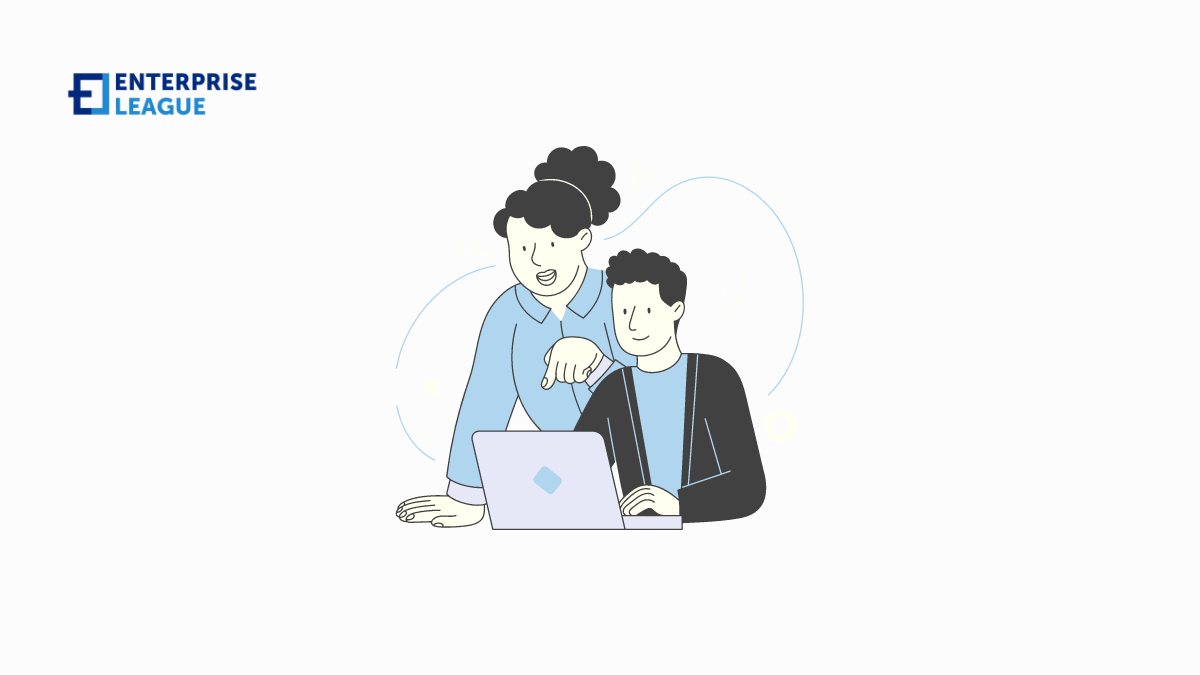Having guidance and connections through life has a significant impact on someone’s ability to become successful. The same goes for business, especially when facing times of being stuck in place and don’t make any progress. If you don’t take any precautions, all of this will lead only to stop growth and pride, which to be honest is the worst enemy of any businessperson.
One way to avoid all of this is to use the power of mentorship and ask for help from an experienced mentor who is willing to share his knowledge, perspectives and offer you an extra hand to get unstacked and achieve things on your own. It’s no wonder that 100% of U.S. Fortune 50 companies have mentoring programs, recognizing the immense value these relationships bring to their organizations and employees.
What is mentorship
The most straightforward way to explain mentorship is to think about it in its most usual form and that is when a more experienced individual or senior called a mentor provides guidance and gives advice to someone less experienced. Basically is a two-way street that often benefits both sides, as mentors more often gain fresh perspectives and renewed enthusiasm from their mentoree.
Mentorship programs
When speaking of mentorship programs, think of it as a team-up between someone who’s already figured some business stuff out and someone who’s still learning but instead of just one person, it’s a whole group of people helping each other out.
Since there are countless mentorship programs that are available, when choosing a program you should consider which one will be suitable for your organization’s needs and interest. So, without further ado let’s break down the most popular ones:
Traditional mentorship
Traditional mentorship is a 1 on 1 model in which the mentor often has a more senior position or greater expertise in the field than the mentee and is focused on guiding the mentee’s professional or personal development. They offer advice, feedback, and support, helping the mentee build confidence, and develop essential skills.
Besides knowledge, traditional mentorship offers benefits like personalized guidance and networking which are of crucial importance for career advancement.
Reverse mentorship
Reverse mentorship flips the traditional mentorship model backward. In this approach, a younger or less experienced employee mentors a more experienced or senior one. The goal is for the mentee to gain insights and knowledge from the reverse mentor, often in areas where the younger generation excels, such as technology, social media, or cultural trends.
For example, the mentor shares their perspectives and expertise on specific topics, and the mentee benefits from this by gaining insights, fresh ideas, and different viewpoints.
Group mentorship
As you can guess by the name, group mentorship presents collaborative learning where a group of employees who have similar goals or interests come together under the guidance of one or more mentors. Unlike traditional 1 on 1 mentorship programs, this model promotes a more dynamic environment where participants learn from each other’s experiences, perspectives, and challenges.
Virtual mentorship
Virtual mentorship is known as e-mentoring or online mentoring. With this model businesses and organizations approach mentorship by taking advantage of technology to connect mentors and mentees regardless of their location and country. This kind of model uses various digital tools like video conferencing, instant messaging, and online platforms to improve communication and knowledge sharing.
One of the perks of virtual mentorship programs is the flexible scheduling and easy accessibility because eliminate location barriers and enable common connections from all over the world.
Peer-to-peer mentorship
Unlike traditional mentorship, where a more experienced employee mentors a less experienced one, peer mentoring is more focused on a mutual exchange of knowledge, skills, and insights.
Think of it as collaborative learning where employees who are at similar levels of experience guide and support each other’s growth and development. The peer-to-peer mentorship model brings different viewpoints and experiences to the table and allows both parties to benefit from the exchange of business knowledge and skills.
Onboarding mentorship
Onboarding mentorship also known as buddy programs is a different approach in which a more experienced employee helps new employees or hires to transition into their roles and company culture by guiding them through their initial weeks or months on the job.
Many companies enhance this process by incorporating onboarding software, which simplifies the introduction and corporate training of new hires. The company matches the mentor who works in the same department or has the same role as the mentee and helps them gain relevant insights and knowledge that are specific to their position. One of the benefits of effective onboarding programs is that allow new hires to become productive members of the team more quickly while reinforcing a supportive company culture where employees feel valued.
Sponsorship
Most of you would be surprised when it comes to using sponsorship as a model for mentoring new hires. Even though sponsorship is often used as a marketing tool to increase brand awareness, gain access to new market segments, and reach new customers, it can also be a powerful form of mentorship that goes beyond traditional guidance and advice.
While mentors offer support and knowledge, sponsors are those who actively vouch for their mentees, opening doors to career advancement and opportunities that otherwise might be out of reach for many.
How companies can establish effective mentorship programs
For one company to establish an effective mentorship program besides a thoughtful approach it will also require a structured one that will include careful planning, clear guidelines, and expectations. So, without any further ado let’s break down the key steps any company or organization should consider:
Defining objectives and guidelines
When it comes to defining clear objectives each business should determine the specific goals they want the mentorship program to achieve. Ask yourself, is your goal to enhance employee development, promote diversity and inclusion, or push leadership growth? This will ensure that everyone understands the program’s purpose, their roles, and their responsibilities leading to a successful program design and implementation.
Don’t forget the cost-benefit analysis that will determine which aspects of the mentorship program will achieve positive outcomes so you can easily present them to your relevant parties or partners.
Recruiting mentors and mentees
To implement a successful mentorship program, take into consideration finding a mentor who will be committed to the program and will have that extra time and resources to offer. For this, you can take advantage of recruitment software or a specialized recruitment agency that will help you out with identifying potential mentors with the right qualifications and availability. Besides knowledge and experience, keep in mind that mentors should also have a passion for leading and helping others succeed. The same approach goes when recruiting a mentee, with a few extra steps using mentee recruitment tools or a mentorship recruitment platform.
Begin with presenting the program to all employees and make sure that is inclusive, regardless of employees’ background, experience level, or department. Share the benefits of participating in the mentorship program and allow mentees to choose the mentorship format they prefer, whether is 1 on 1, group, or online. A learning management system (LMS) or employee engagement platform can be beneficial for organizing and delivering different mentorship formats, especially for online or group sessions.
Designing the structure of mentorship programs
When designing the structure of the mentorship program, keep in mind to focus on flexibility and adaptability so you can meet the needs of the team members. The point is to create a supportive and impactful learning experience that would benefit both mentors and mentees, not to add pressure on overworked employees or make them feel obligated. Start by choosing the mentorship model, then proceed to set the timeline like the duration of the program and meeting schedules.
Don’t forget to lay the foundations of communication channels through which the participants will exchange different viewpoints, ideas, or insights. Whether it’s in person, online meetings, or other online platforms, whichever you choose just make sure it will be efficient and will allow clear communication among the participants.
Measuring the success of mentorship
Measuring the success of mentorship involves assessing both the tangible and intangible outcomes for both the mentor and mentee. By tracking key performance indicators on an ongoing basis, such as the completion of goals that were set by the mentee at the beginning of the mentorship program, you could easily see if there’s progress and knowledge gained during the program. Monitor key performance indicators like the frequency and duration of mentoring sessions as well as the participation in them. The higher the engagement is, the greater success is achieved.
Finally, be transparent with your partners or investors, and make sure you give regular updates on each mentorship program, whether showing achieved milestones or goals that still need to be met.
Conclusion
At the end of the day, we can all agree that the power of mentorship is undeniable. Its influence extends beyond the immediate goals and aspirations of employees, impacting organizations and businesses as a whole. Through guidance, support, and shared experiences, mentorship fosters growth, builds confidence, and ignites potential.
More must-read stories from Enterprise League:
- Inspiring quotes about supporting small businesses.
- Engaging online networking events that you should not miss.
- Debunking the most common myths of entrepreneurship.
- Learn how to deal with rude customers in a creative way.
- A step-by-step guide to teach you how to write a business essay.
Related Articles
Best 1800 Number Providers In Australia
If you're operating a business in Australia, it's in your best interest to invest in the right tools to give you an advantage in your respective field. One tool that many local entrepreneurs often overlook is a business number, particularly an 1800 number. 1800...
Where to Find Affordable Election Services for Unions
Every year, thousands of labor or trade organizations across the country hold elections to choose representatives. This creates a demand for affordable election service providers that help unions manage the logistics. Election services for unions come in many...
Workplace Violence or Drug Accusations: Protecting Yourself Legally
Accusations of workplace violence or drug-related misconduct can derail a career, even when the claims are unfounded. A single allegation can lead to suspension, internal investigations, damaged professional relationships, and in serious cases, criminal charges....
Best 1800 Number Providers In Australia
If you're operating a business in Australia, it's in your best interest to invest in the right tools to give you an advantage in your respective field. One tool that many local entrepreneurs often overlook is a business number, particularly an 1800 number. 1800...
Where to Find Affordable Election Services for Unions
Every year, thousands of labor or trade organizations across the country hold elections to choose representatives. This creates a demand for affordable election service providers that help unions manage the logistics. Election services for unions come in many...






